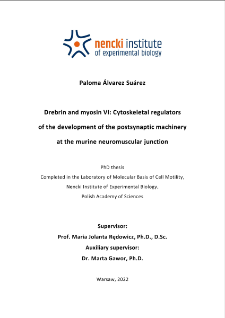- Search in all Repository
- Literature and maps
- Archeology
- Mills database
- Natural sciences
Advanced search
Advanced search
Advanced search
Advanced search
Advanced search

Object
Title: Drebrin and myosin VI : cytoskeletal regulators of the development of the postsynaptic machinery at the murine neuromuscular junction : PhD thesis
Institutional creator:
Instytut Biologii Doświadczalnej im. Marcelego Nenckiego PAN
Contributor:
Rędowicz, Maria Jolanta : Supervisor ; Gawor, Marta : Supevisor
Publisher:
Nencki Institute of Experimental Biology PAS
Place of publishing:
Description:
183 pages : illustrations ; 30 cm ; Bibliography ; Summary in Polish
Degree name:
Degree discipline :
Degree grantor:
Nencki Institute of Experimental Biology PAS ; degree obtained on 12/10/2022
Type of object:
Abstract:
The neuromuscular junction (NMJ) is a chemical synapse of the peripheral nervous system that enables skeletal muscle contraction through acetylcholine-mediated neurotransmission. This synaptic structure is composed of three main elements, motor neuron, myofiber, and Schwann cells, that tightly regulate one another throughout ontogenesis via multiple signaling pathways. Disruption of these pathways can result in neuromuscular disorders that reduce the efficiency of muscle contraction and lead to muscle fatigue, wasting, and, in some cases, premature death. The cause of many neuromuscular disorders remains unknown to this date and any cure or treatment is often missing. Studying the molecular mechanisms underlying NMJ function in physiological and pathological contexts could shed light on these unmet clinical needs and even lay the path to discovering therapeutic targets. Impairments in cellular processes regulating the presence of acetylcholine receptors (AChRs) on the myofiber surface are one of the most devastating for proper NMJ function. Most importantly, many signaling pathways and developmental processes involved in receptor clustering and maintenance remain poorly understood, and researchers continue to unveil new roles for proteins whose relevance at the NMJ had been unknown before. The actin cytoskeleton and actin-remodeling proteins are at the core of many postsynaptic-regulating processes, including local delivery and recycling of synaptic components, stabilization of postsynaptic complexes, and recruitment of other cytoskeletal filaments. Through my PhD research, I identified and characterized for the first time some of the functions of the cytoskeletal regulators drebrin and myosin VI in the formation and maintenance of the postsynaptic machinery. Specifically, I found that drebrin plays an important role in AChR clustering and maturation through its ability to rearrange actin filaments. Moreover, its mechanisms of action at the postsynaptic machinery seem to involve microtubule organization and interaction with rapsyn, a key AChR clustering mediator and stabilizer. Myosin VI, on the other hand, does not seem to be crucial neither for NMJ formation nor maturation, however its absence in mice significantly impairs NMJ structure and leads to reduced muscle strength, particularly in females. Altogether, my results provide an insight into the mechanisms through which drebrin mediates AChR cluster formation, maturation, and maintenance, as well as the functional consequences of myosin VI loss in the skeletal muscle of mice
Detailed Resource Type:
Resource Identifier:
Source:
Language:
Language of abstract:
Rights:
Terms of use:
Copyright-protected material. May be used within the limits of statutory user freedoms
Copyright holder:
Publication made available with the written permission of the author
Digitizing institution:
Nencki Institute of Experimental Biology of the Polish Academy of Sciences
Original in:
Library of the Nencki Institute of Experimental Biology PAS
Access:
Object collections:
- Digital Repository of Scientific Institutes > Partners' collections > Nencki Institute of Experimental Biology PAS
- Digital Repository of Scientific Institutes > Partners' collections > Nencki Institute of Experimental Biology PAS > Dissertations
- Digital Repository of Scientific Institutes > Partners' collections > Nencki Institute of Experimental Biology PAS > Dissertations > PhD Thesis
- Digital Repository of Scientific Institutes > Literature
- Digital Repository of Scientific Institutes > Literature > Thesis
Last modified:
Dec 16, 2024
In our library since:
Oct 20, 2022
Number of object content downloads / hits:
201
All available object's versions:
https://rcin.org.pl./publication/272926
Show description in RDF format:
Show description in RDFa format:
Show description in OAI-PMH format:
Objects Similar
Głowacka, Anna (1989– )
Nowak, Jolanta
Witkowska, A. Kotik, T.

 INSTYTUT ARCHEOLOGII I ETNOLOGII POLSKIEJ AKADEMII NAUK
INSTYTUT ARCHEOLOGII I ETNOLOGII POLSKIEJ AKADEMII NAUK
 INSTYTUT BADAŃ LITERACKICH POLSKIEJ AKADEMII NAUK
INSTYTUT BADAŃ LITERACKICH POLSKIEJ AKADEMII NAUK
 INSTYTUT BADAWCZY LEŚNICTWA
INSTYTUT BADAWCZY LEŚNICTWA
 INSTYTUT BIOLOGII DOŚWIADCZALNEJ IM. MARCELEGO NENCKIEGO POLSKIEJ AKADEMII NAUK
INSTYTUT BIOLOGII DOŚWIADCZALNEJ IM. MARCELEGO NENCKIEGO POLSKIEJ AKADEMII NAUK
 INSTYTUT BIOLOGII SSAKÓW POLSKIEJ AKADEMII NAUK
INSTYTUT BIOLOGII SSAKÓW POLSKIEJ AKADEMII NAUK
 INSTYTUT CHEMII FIZYCZNEJ PAN
INSTYTUT CHEMII FIZYCZNEJ PAN
 INSTYTUT CHEMII ORGANICZNEJ PAN
INSTYTUT CHEMII ORGANICZNEJ PAN
 INSTYTUT FILOZOFII I SOCJOLOGII PAN
INSTYTUT FILOZOFII I SOCJOLOGII PAN
 INSTYTUT GEOGRAFII I PRZESTRZENNEGO ZAGOSPODAROWANIA PAN
INSTYTUT GEOGRAFII I PRZESTRZENNEGO ZAGOSPODAROWANIA PAN
 INSTYTUT HISTORII im. TADEUSZA MANTEUFFLA POLSKIEJ AKADEMII NAUK
INSTYTUT HISTORII im. TADEUSZA MANTEUFFLA POLSKIEJ AKADEMII NAUK
 INSTYTUT JĘZYKA POLSKIEGO POLSKIEJ AKADEMII NAUK
INSTYTUT JĘZYKA POLSKIEGO POLSKIEJ AKADEMII NAUK
 INSTYTUT MATEMATYCZNY PAN
INSTYTUT MATEMATYCZNY PAN
 INSTYTUT MEDYCYNY DOŚWIADCZALNEJ I KLINICZNEJ IM.MIROSŁAWA MOSSAKOWSKIEGO POLSKIEJ AKADEMII NAUK
INSTYTUT MEDYCYNY DOŚWIADCZALNEJ I KLINICZNEJ IM.MIROSŁAWA MOSSAKOWSKIEGO POLSKIEJ AKADEMII NAUK
 INSTYTUT PODSTAWOWYCH PROBLEMÓW TECHNIKI PAN
INSTYTUT PODSTAWOWYCH PROBLEMÓW TECHNIKI PAN
 INSTYTUT SLAWISTYKI PAN
INSTYTUT SLAWISTYKI PAN
 SIEĆ BADAWCZA ŁUKASIEWICZ - INSTYTUT TECHNOLOGII MATERIAŁÓW ELEKTRONICZNYCH
SIEĆ BADAWCZA ŁUKASIEWICZ - INSTYTUT TECHNOLOGII MATERIAŁÓW ELEKTRONICZNYCH
 MUZEUM I INSTYTUT ZOOLOGII POLSKIEJ AKADEMII NAUK
MUZEUM I INSTYTUT ZOOLOGII POLSKIEJ AKADEMII NAUK
 INSTYTUT BADAŃ SYSTEMOWYCH PAN
INSTYTUT BADAŃ SYSTEMOWYCH PAN
 INSTYTUT BOTANIKI IM. WŁADYSŁAWA SZAFERA POLSKIEJ AKADEMII NAUK
INSTYTUT BOTANIKI IM. WŁADYSŁAWA SZAFERA POLSKIEJ AKADEMII NAUK


































